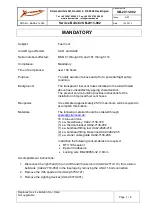
10
PLEASE, READ THIS CAREFULLY: RISK OF FULL STALL
1.
As can be seen on the EN Certifi cation, the PEAK has a relatively short
brake travel and it should be noted that by reaching for the A3 line to
make big ears it is possible to apply brake pressure without realising it. The
same happens whilst pulling down the A3 line to make the ears. This can
obviously lead to a signifi cant speed decrease.
2.
The PEAK has a new high arch concept and applying ears induces
more resistance. With this new arch, the ears don’t stick to the intrados
but they do tend to “hang”. Because of this, there will be more resistance,
compared to ears on a standard glider.
3.
Because of the design concept, the PEAK has a low transverse tension,
which results in less pitch. This is good in normal conditions however on
the other hand the glider could get into trouble if it is allowed pitch and
achieve an extreme angle of incidence.
These are 3 particularities, which together with turbulent conditions
could cause an unintentional stall.
The Solution:
Big ears may still be applied but the pilot must be fully aware of the above-
mentioned points and act accordingly. To avoid the stall simply use the
accelerator halfway (this is suffi cient) to increase the speed, which naturally
decreases the angle of incidence. In this way you will maintain a safe
margin and avoid this phenomenon.
Take care not to pull the brakes while making the ears !!
Some pilots would say:
“Nothing is better than a good descending air mass to descend safely!”
5.2 B-LINE STALL
When you carry out this manoeuvre, the wing stops fl ying, it loses all
horizontal speed and you are not in control of the paraglider. The air
circulation over the profi le is interrupted and the wing enters into a situation
similar to parachuting.
To carry out this manoeuvre you have to take the B-risers below the maillons
and symmetrically pull both of them down (approx. 20-30cms) and then
hold this position. The initial phase is quite physical (hard resistance)
which means that you will have to pull strongly until the profi le of the wing
is deformed, when this happens the required force will then signifi cantly
reduce. To maintain this manoeuvre you must continue to hold the B Lines
in the pulled down position. The wing will then become deformed, horizontal
speed drops to 0 km/h and vertical speed increases to –6 to –8 m/s
depending on the conditions and how the manoeuvre has been performed.
To exit the manoeuvre, simultaneously release both risers, the wing will
then slightly surge forward and then automatically return to normal fl ight.
It is better to let go of the lines quickly rather than slowly. This is an easy
manoeuvre but you must remember that the wing stops fl ying, it loses all
horizontal movement and its reactions are very different compared to
normal fl ight.
5.3 SPIRAL DIVE
This is a more effective way for rapidly losing height. You have to know that,
the wing can gain a lot of speed and the increase in G’s will be substantial.
This can cause a loss of orientation and consciousness (blackouts). These
are the reasons why it is best to carry out this manoeuvre gradually so your
capacity to resist the G forces increases and you will learn to fully appreciate
and understand the manoeuvre. Always practice this manoeuvre when fl ying
at high altitude.
To start the manoeuvre, fi rst lean your bodyweight and pull the brake line to
the side to which you are leaning. You can regulate the intensity of the turn
by applying a little outside brake.
A paraglider fl ying at its maximum turn speed can reach –20 m/s, equivalent
70 km/h vertical speed and stabilize in a spiral dive from 15 m/s onwards.
These are the reasons why you should be familiar with the manoeuvre and
Summary of Contents for PEAK 23
Page 1: ...PEAK USER S MANUAL...
Page 14: ...14 11 3 RISER ARRANGEMENT PEAK...
Page 15: ...15 11 4 LINE PLAN PEAK...
Page 20: ...niviuk com The importance of small details Bisgr c...




























